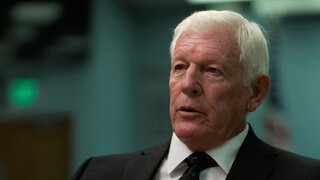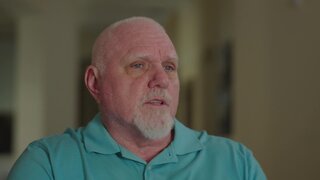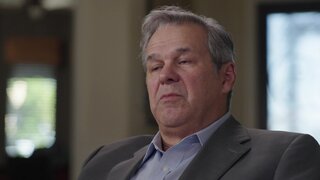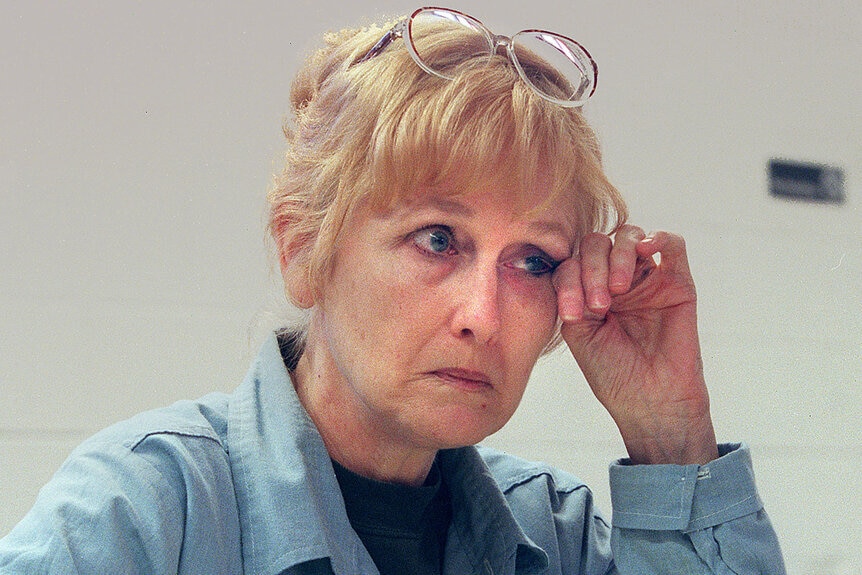Create a free profile to get unlimited access to exclusive videos, breaking news, sweepstakes, and more!
Was A Convicted ‘Black Widow’ Responsible For The Murder Of A Las Vegas Mogul?
Margaret Rudin was convicted of shooting and decapitating her millionaire husband, though her conviction was overturned years later.
A real estate magnate’s disappearance and murder nearly 30 years ago continues to spark questions over whether his wife was actually involved.
Las Vegas millionaire Ron Rudin disappeared on Dec. 17, 1994, the same day he was due to attend a grand opening for his wife’s new antique store. The wife, Margaret Rudin, assumed her husband was held up with a business deal, as the Illinois-raised businessman had explained earlier that day.
“Margaret worked late that night,” Las Vegas Metropolitan Police Det. Wayne Peterson told Blood & Money, airing Saturdays at 9/8c on Oxygen. “When she finally went home at 1:30 a.m., Ron and Ron’s car was missing.”
According to Margaret’s attorney, Greg Mullanax, his client called the LVMPD and was advised to wait 48 hours before filing a missing persons report. When Ron failed the show up at the office for the second morning in a row, an official report was made by his employees on Dec. 20.
“Ron Rudin’s persona wasn’t to be in the casinos; he was a businessman,” said family friend JB Casell. “He was a mover and a shaker. He could get things done.”
Ron seemed to have it all after marrying Margaret, who — like Ron — had been unlucky in love. For both husband and wife, it was marriage number five.
“Ron’s wife, Margaret, was a sweet southern belle,” author Mike Fleeman said. “But she also had nerves of steel, and she had a tough life, too. She came from nothing, she married badly, divorced badly.”
A Dec. 22 search of the Rudin’s Las Vegas home didn’t reveal much for investigators, though there were red flags when Ron’s Cadillac was found two days later at the Crazy Horse Too, a now-closed strip club of ill-repute, which acted as a front for organized crime. It was a peculiar scene for detectives, who believed the car was wiped of any fingerprints, though four muddy boot prints were discovered inside.
Rumors soon started that perhaps the mafia had something to do with Ron’s disappearance, leading investigators to take a closer look at his business dealings. They found Ron was working up a land deal surrounding the Lee Canyon resort at Mount Charleston, about 30 miles outside Las Vegas.
Some believed Ron went to the mafia so they could finance his development, according to the missing man’s employees.
“At the time of his deal up in Mount Charleston, Ron had lost his real estate license,” said friend JB Casell. “And he had several complaints on him from the real estate board, but it didn’t slow him down. He was still conducting business.”
One month after Ron’s disappearance, on Jan. 21, 1995, night fishermen at Lake Mohave came upon a burned human skull about 70 yards off a desert road in Laughlin, Nevada, some 100 miles from Ron and Margaret’s home. Investigators arrived, finding more human remains in a nearby burn pit containing hardware from a chest. They also observed drag marks and a bracelet with the inscription “Ron” at the scene.
Days later, a medical examiner concluded the body belonged to Ron Rudin, who had been shot four times in the head and decapitated.
"It really had the earmarks of a mob hit,” said Casell. “I think people have been killed for a lot less.”
When delivering the tragic news to Ron’s widow, detectives grew suspicious when she allegedly began grinding her fist near her eye, supposedly to make herself cry. Adding to the suspicion was the fact that Margaret became embroiled with the trustees of Ron’s estate, valued at around $10 million to $12 million, per investigators.
Margaret was bequeathed 60% but reportedly demanded more, according to Clark County Prosecutor Thomas Moskal.
“When detectives looked at Ron Rudin’s will, there was a secret directive that says if he dies under suspicious means, that any beneficiary named in that will needed to be investigated,” said Moskal.
The business-related trustees soon used their top-dollar attorneys to cut Margaret out by severing payments from Ron’s salary and going as far as to cancel her newspaper subscriptions, according to her attorney Greg Mullanax. The trustees did, however, issue a $25,000 reward for anyone with information about Ron’s homicide.
Days later, a handyman named Augustine Lovato went to the police, claiming Margaret hired him to renovate her and Ron’s bedroom, where Lovato allegedly saw blood “gurgling” from the drain of the couple’s en suite sink. He also stated he saw blood on the carpet after moving the bed.
Later forensic searches yielded few results.
Lovato’s tip wasn’t enough to charge Margaret, so investigators returned to the physical evidence of the crime scene. They learned the burned trunk was an antique and not dissimilar to one sold to Margaret for her new store by a California man named Bruce Honanbach.
But detectives wondered how someone Margaret’s size could haul a trunk with Ron’s 220-pound body alone, leading them to look into the possibility of an accomplice.
“Margaret’s sister said that Margaret was having an affair with this gentleman named Yehuda Sharon,” according to LVMPD detective Wayne Petersen.
Yehuda Sharon was a younger man from Israel who allegedly swooned middle-aged women at the local country club, according to Mullanax. But upon a closer look, detectives learned that Ron Rudin had also been unfaithful many times.
Although the infidelity caused arguments in the marriage, investigators believed money made Margaret stay for fears that she’d end up empty-handed if she followed through with her fifth divorce.
Then, on July 21, 1996 — more than a year after Ron’s murder — detectives got a break in the case when they caught wind that a gun had been sitting in an evidence locker for more than a year after divers found it in Lake Mead.
The gun was registered to Ron Rudin, and later ballistic tests revealed it was the murder weapon.
Ron owned thousands of guns and had previously reported this particular gun stolen before he disappeared. For investigators, it seemed less likely that the mob could have been responsible when Margaret had the easiest access to the firearm.
On April 17, 1997, a Clark County grand jury indicted Margaret with first-degree murder with the use of a deadly weapon. But by then, Margaret was long gone.
Margaret obtained fake I.D. cards and spent two years in Mexico and elsewhere in the United States. After being featured on America’s Most Wanted, a tip led police to Massachusetts, where Margaret worked as a pizza deliverer. She was arrested and taken back to Nevada.
The trial began in Clark County in March 2001 — six years after Ron’s murder — and would become the longest trial in Nevada’s history. The trial’s high publicity earned Margaret the moniker “The Black Widow.”
One of the more peculiar aspects of the trial came from her then-defense attorney, Michael Amador, who gave opening and closing statements that were more rambling hour-plus-long tangents.
“If you watched Michael Amador’s opening statement, you’d be hard-pressed to find a coherent defense theory,” according to Mullanax. “Michael Amador gets lost in the weeds.”
Amador was allegedly in secret negotiations with media outlets for the rights to his client’s story. His courtroom arguments had little to do with what evidence there was as part of his client’s case and included discussions of his son’s soccer games.
But the trial continued — despite the judge admonishing Amador for “sandbagging” — and featured several key prosecution witnesses, including Bruce Honanbach, the man who allegedly sold Margaret the antique chest found at Ron’s crime scene.
“What he testifies to is that he bought a humpback trunk from a Donald Schaupeter and that he provided that trunk to Margaret Rudin for her antique store,” said prosecutor Moskal.
Jury foreman Ron Vest said Honanbach’s testimony significantly influenced the final verdict.
“Margaret dealt with Honanbach on many transactions,” said Vest. “About 10 or 12 times, according to his testimony, she told him, ‘I wish my husband was dead.’”
“To me, that was huge,” he added.
However, Donald Schaupeter, who’d been watching the trial on television, called defense attorney Amador and later testified that he never sold Honanbach a trunk, calling Honanbach’s testimony into question.
It wasn’t the only setback for prosecutors.
“One of the problems that we had in the prosecution of the case was Margaret Rudin was not going to be physically capable to carry out the execution and also dispose of the body in the way that it was done,” said Moskal.
Still looking for a possible accomplice, prosecutors looked to Yehuda Sharon, Margaret’s paramour. He was offered immunity for his testimony; however, the prosecution failed to outline the aspects to which he was required to testify. On the stand, he denied knowing anything about the murder, and because of the immunity deal with prosecutors, Sharon could not be pursued as a suspect in the case.
“The prosecution was so certain it was Yehuda Sharon,” said author Mike Fleeman. “He is supposedly involved with Margaret Rudin, and he was physically strong enough to drag a trunk containing a six-foot-whatever man out to the desert and set it on fire.”
Augustine Lovato — the handyman who reported seeing blood in the Rudin bedroom — also took the stand. Physical evidence seemed to contradict his claims, and he was portrayed as someone who was only out to grab the recent $25,000 reward provided by Ron’s estate trustees.
But with only Margaret on the hook for her husband’s murder, she was found guilty and sentenced to 20 years to life behind bars.
She spent the next 19 years at the Florence McClure Women’s Correctional Center in Las Vegas before being released on parole on Jan. 10, 2020, during the COVID-19 pandemic. Following her release, she contacted Mullanax, hoping to clear her name, despite her already serving her time.
Prominently on the grounds of ineffective counsel, Margaret was afforded an appeal, and on May 16, 2022, a federal judge vacated her murder conviction. But since she’d already served her time, there was no need for a retrial.
“This is unfortunate; there’s no winners here,” said family friend JB Casell. “Ron Rudin lost his life. Margaret Rudin lost hers. Was law and order served? I don’t believe so. We still don’t have a convicted killer.”
Margaret is now 79 years old and maintains her innocence.
To see more Blood & Money, tune in to Oxygen Saturdays at 9/8c.






















